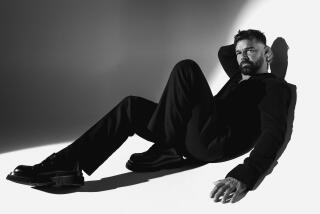MOVIE REVIEW : ‘Father of the Bride’: Wedding Bell Blues for Martin
Set in prettily lacquered Southern California suburbia--what studio pressbooks usually refer to as “Norman Rockwellian”--the remake of “Father of the Bride” (citywide) smudges our pleasant memories of the original. It replaces them with something smirkier, more complacent and hollow.
The movie is like a big, smug, sunny ball of fluff, batting around in a crystalline cage. It’s bright and well-meaning, but there’s little to grab onto or feel. Not even the presence of those expert actor/ farceurs , Steve Martin and Diane Keaton, in the original Spencer Tracy and Joan Bennett parts, give it any real presence or bite.
By contrast, the 1950 Vincente Minnelli version was a gentle, graceful comic nightmare. In it, dad Tracy found daughter Liz Taylor’s wedding turning into a private purgatory. When Tracy’s George Banks emerged at the end, a little stunned, defeated by every inflated or expensive ritual thrust upon him, we realized that his humanity, and his family’s, were more important than the conventions--that love could filter through anyway.
But the new “Father of the Bride” seems to adore the conventions as much as the family. It’s dippy about everything: the Bankses, their wedding, their wonderful in-laws, their terrific home, their adorable misfortunes and catastrophes. “My life . . . is good ,” growled sleazy Angeleno Randy Newman in “Trouble in Paradise,” and that’s what Martin tells us at the start, without either Newman’s or Tracy’s irony, as he cruises around Pasadena.
This “Father of the Bride”--too tactfully updated by the producer-director-co-writer team of Nancy Meyers and Charles Shyer--tends to treat the whole wedding like a jolly reunion, where everyone is nice as pie, and twice as scrumptious. (One of the 1950 Banks’ children, Tom Irish, even shows up in a cameo, as great-uncle Ben.)
Reviving the original’s plot and characters, and including so much of its dialogue that 1950 writers Frances Goodrich and Albert Hackett get--and deserve--co-writer credit, Meyers and Shyer still manage to markedly shift the tone. There’s some sarcasm in this movie, but no urgency.
The updating is pretty obvious. The women’s roles have been made more independent, and there’s some ‘60s nostalgia, including Phil Spector wedding ballads on the soundtrack. But, by trimming the Banks women--Keaton and Kimberly Williams--of most of the materialism or callowness that made them funny in 1950, turning them into role models of a sort, the movie dries up its own comic juices. This is the sort of film where the writers include a one-on-one basketball match between a father and daughter, so the daughter can win.
Steve Martin should have been great as George Banks. He has the depth to follow Tracy in the role and a flair for comic smugness and middle-class resentments. But, since his purgatory has been largely stolen or diminished, Martin doesn’t have much to react to. His Banks becomes a sort of comic crank, close to the usual stumblebum sitcom dad. And Martin is often reduced to his own private shtick and slapstick--hiding under desks, falling out of windows or doing Tom Jones imitations--to try to jack up the comedy.
Midway through “Father of the Bride” (MPAA rated PG), Martin Short shows up, as the effete, snobbish wedding coordinator that Leo G. Carroll played in the original, and steals the movie from Martin, steals it from everybody. Short’s handling of this silly little role--an outrageous poseur named “Franck Eggelhoffer” who insists on calling himself Frawwnk and acts like a post-disco Mischa Auer--has perfect pitch and real wigged-out comic genius. He turns Franck into another of his electric-haired, glassy-eyed little dippo-flippos, a Beverly Hills caricature soaring into the comic ether. And perhaps the reason the audience can take such pleasure in the way he disrupts and tears apart the Banks household is a feeling that it should be disrupted, that enough is enough.
At the end of the 1950 “Father” there was a real charge when Tracy and Bennett waltzed; we felt that he’d survived a well-mannered hell. But how can we empathize with Martin and Keaton for surviving heaven: even a heaven catered by an Eggelhoffer?
‘Father of the Bride’
Steve Martin: George Banks
Diane Keaton: Nina Banks
Kimberly Williams: Annie Banks
Martin Short: Franck Eggelhoffer
A Touchstone Pictures/Touchstone Pacific Partners I presentation of a Sandy Gallin production, released by Buena Vista Distribution. Director Charles Shyer. Producers Nancy Meyers, Carol Baum, Howard Rosenman. Executive producers Sandy Gallin, James Orr, Jim Cruickshank. Screenplay by Frances Goodrich, Albert Hackett, Meyers, Shyer. Cinematographer John Lindley. Editor Richard Marks. Costumes Susan Becker. Music Alan Silvestri. Production design Sandy Veneziano. Art director Erin Cummins. Running time: 1 hour, 54 minutes.
MPAA-rated PG
More to Read
Only good movies
Get the Indie Focus newsletter, Mark Olsen's weekly guide to the world of cinema.
You may occasionally receive promotional content from the Los Angeles Times.







